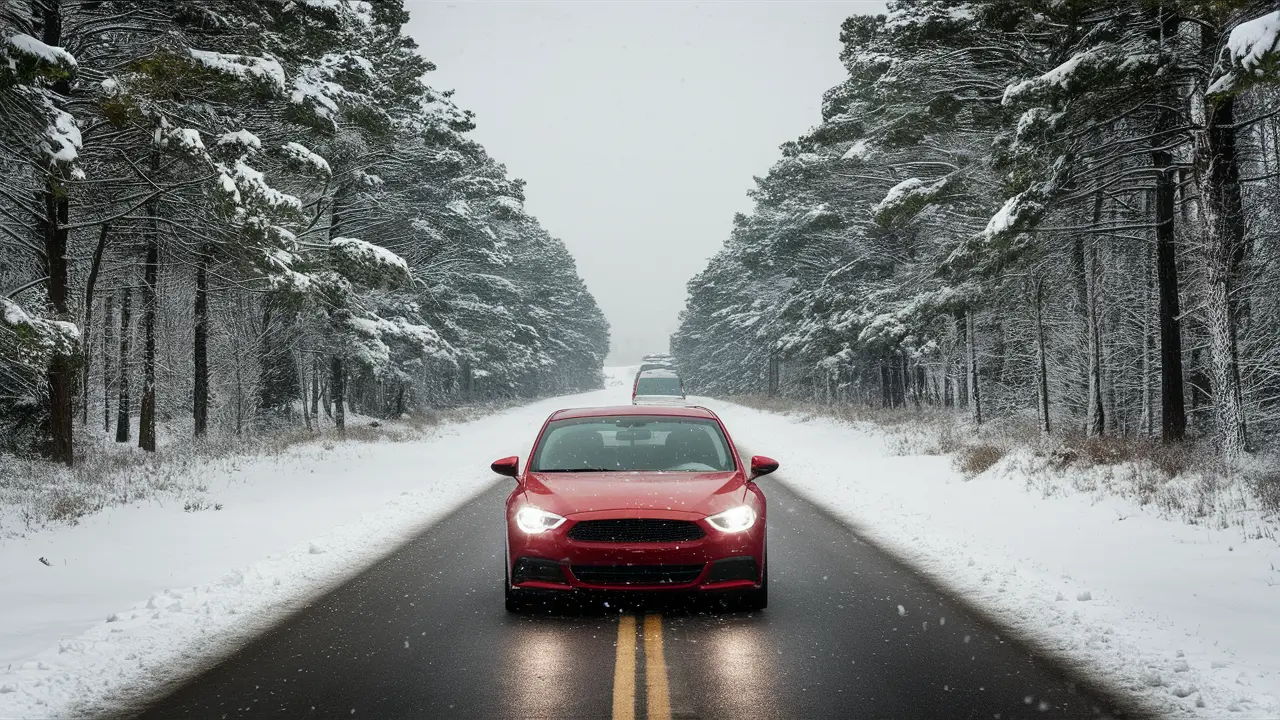20mp snow road following distance winter driving presents unique challenges that require extra caution and preparation. Snow-covered roads, reduced visibility, and icy conditions can turn a routine drive into a dangerous journey.
One of the most critical aspects of safe winter driving is maintaining an appropriate following distance, especially when driving at 20 miles per hour (MPH) on feather snow road.
The importance of following distance in snowy conditions, provide practical tips for maintaining safety, and explain why the 20MPH snow road following distance is crucial for your safety and others on the road.
Understanding the 20MP Snow Road Following Distance
What is Following Distance?
Following distance refers to the space between your vehicle and the vehicle in front of you.
This distance gives you enough time to react if the vehicle ahead suddenly stops or slows down.
In ideal conditions, a three-second following distance is usually sufficient.
However, winter conditions require a much greater following distance due to the reduced traction and longer stopping distances on snow and ice.
Why 20MPH?
Driving at 20MPH in snowy conditions is often necessary because of the reduced visibility and traction.
At this speed, your vehicle has a better chance of maintaining control, and it allows you to react more effectively to unexpected changes in road conditions.
The 20MPH feather snow road usa following distance is a critical component of safe winter driving, as it provides the necessary buffer to prevent accidents.
The Science Behind Safe Following Distances
Traction and Braking on Snow
Snow significantly reduces the traction between your tires and the road, making it more challenging to stop your vehicle quickly.
Even at low speeds, such as 20MPH, your stopping distance can be two to three times longer than on dry pavement.
This means that if you’re following too closely, you may not have enough time to stop before colliding with the vehicle in front of you.
The Role of Reaction Time
Reaction time is the time it takes for you to recognize a hazard and begin braking.
On apartments snow road parma ohio, the combination of slower reaction times due to reduced visibility and longer stopping distances makes maintaining a safe following distance even more critical.
By keeping a greater distance between your vehicle and the one ahead, you increase the margin for error and reduce the likelihood of an accident.
How to Determine the Right Following Distance at 20MP
The Four-Second Rule
In winter driving conditions, it’s recommended to use the “four-second rule” to maintain a safe following distance.
This rule involves selecting a stationary object on the side of the road, such as a sign or tree. When the vehicle ahead passes the object, start counting.
If it takes at least four seconds before you pass the same object, you’re maintaining a safe following distance.
On snowy roads at 20MPH, this rule can be extended to six seconds or more to account for the increased stopping distance.
Adapting to Road Conditions
The condition of the road plays a significant role in determining the appropriate following distance.
On snow-packed roads, you should increase your following distance even further.
If apartments 11000 snow road parma ohio road is icy or visibility is severely reduced, it may be necessary to double or even triple the standard four-second rule.
Always adjust your following distance based on the current conditions, erring on the side of caution.
Maintaining a Safe 20MP Snow Road
Stay Focused and Avoid Distractions
Maintaining a safe following distance requires your full attention.
Distracted driving, whether from using a phone, adjusting the radio, or eating, reduces your ability to react quickly to changes in traffic.
Keep your focus on the road and constantly monitor the vehicle ahead to ensure you’re maintaining the proper distance.
Use Your Vehicle’s Safety Features
Many modern vehicles come equipped with safety features that can help you maintain a safe following distance.
Adaptive cruise control, for example, automatically adjusts your speed to keep a set distance from the vehicle in front of you.
While these features can be helpful, they should not be relied upon entirely. Always be prepared to take control of your vehicle and adjust your following distance as needed.
Avoid Sudden Movements
Sudden movements, such as hard braking or sharp turns, can cause your vehicle to lose traction on snow-covered roads.
To maintain a safe following distance, drive smoothly and gradually. If you need to slow down, do so gradually to give the vehicle behind you ample time to react.
This approach not only helps you maintain control of your vehicle but also reduces the risk of a rear-end collision.
Monitor Your Speed
Even at 20MPH, it’s important to monitor your speed and adjust it based on the road conditions.
If the road is particularly icy or visibility is poor, you may need to reduce your speed even further. Remember, the goal is not to reach your destination quickly but to arrive safely.
By keeping your speed in check, you’ll have more time to react to potential hazards and maintain a safe following distance.
Common Mistakes to Avoid
Tailgating
Tailgating is one of the most dangerous behaviors on snowy roads. Following too closely leaves you with little to no time to react if the vehicle ahead stops where is feather snow road located.
In winter conditions, this can easily lead to a chain-reaction collision. Always maintain a safe following distance, especially at 20MPH on snow-covered roads.
Overconfidence in Vehicle Capabilities
Four-wheel drive, all-wheel drive, and winter tires can improve traction, but they do not eliminate the need for a safe 20mp snow road following distance.
These features can give you a false sense of security, leading you to follow too closely. Regardless of your vehicle’s capabilities, always maintain a safe distance from the vehicle ahead.
Ignoring Road Conditions
It’s easy to become complacent and assume that all snowy roads are the same.
However, road conditions can vary greatly depending on factors such as temperature, traffic, and the amount of snow and ice.
Always pay attention to the current road conditions and adjust your 20mp snow road following distance accordingly. What worked on one stretch of road may not be safe on another.
Role of Weather
Snowfall Intensity
The intensity of snowfall can have a significant impact on visibility and road conditions.
Heavy snowfall reduces visibility and can quickly cover the road, 20mp snow road following distance making it difficult to see lane markings and obstacles.
In these conditions, it’s essential to increase your following distance to give yourself more time to react to the unexpected.
Temperature Fluctuations
Temperature changes can affect the road’s surface, causing it to go from wet to icy in a short period.
When temperatures hover around freezing, be especially cautious and increase your following distance.
Even a slight drop in temperature can turn a wet road into a sheet of ice, dramatically increasing stopping distances.
Wind Conditions
Strong winds can create snowdrifts and blow snow across the road, further reducing visibility and traction.
In windy conditions, it’s crucial to maintain a safe following distance and be prepared for sudden changes in road conditions.
Keep both hands on the wheel and drive at a steady speed to help maintain control of your vehicle.
Importance of Proper Vehicle Maintenance
Winter Tires
Winter tires provide better traction on snow and ice than all-season tires. They have deeper treads and are made from a rubber compound that remains flexible in cold temperatures.
If you frequently drive in snowy conditions, investing in a set of winter tires can help you maintain control and reduce stopping distances, allowing you to keep a safer following distance.
Regular Brake Checks
Your vehicle’s brakes are your first line of defense when it comes to stopping safely.
Regular brake inspections and maintenance are essential, especially before winter arrives. Ensure that your brakes are in good working order to maximize your stopping power on snow-covered roads.
Windshield Wipers and Washer Fluid
Visibility is critical when driving in snowy conditions. Make sure your windshield wipers are in good condition and replace them if necessary.
Additionally, keep your windshield washer fluid reservoir full with a fluid that won’t freeze in cold temperatures.
Good visibility allows you to better judge your following distance and react to changes in traffic.
Emergency Preparedness
What to Do If You Start to Slide
Even with a safe following distance, there’s always a chance you could lose control of your vehicle on a 20mp snow road following distance.
If you start to slide, stay calm and avoid slamming on the brakes. Instead, gently steer in the direction you want to go and lightly pump the brakes if necessary.
Keeping a safe following distance gives you more time to regain control before coming too close to the vehicle ahead.
Having an Emergency Kit
An emergency kit is essential for winter driving. Include items such as a blanket, flashlight, first-aid kit, non-perishable food, water, and a shovel.
If you become stranded, these items can keep you safe and comfortable while you wait for help. Additionally, carry traction aids like sand or kitty litter to help you get your vehicle moving if you get stuck.
Knowing When to Stay Off the Roads
Sometimes, the best way to maintain a safe following distance is to stay off the roads altogether.
If the weather forecast predicts severe winter conditions, consider postponing your trip until the roads are safer. No destination is worth risking your safety.
Use common sense and avoid driving in dangerous conditions whenever possible.
Conclusion
Maintaining a safe 20MPH feather snow road usa location following distance is one of the most important aspects of winter driving.
By understanding the science behind stopping distances, adapting to road conditions, and following practical safety tips, you can significantly reduce your risk of an accident.
Remember that winter driving requires patience, attention, and preparation.
Prioritize safety over speed, and always be prepared for the unexpected.
With the right mindset and precautions, you can navigate snowy roads with confidence and arrive at your destination safely.

